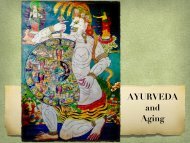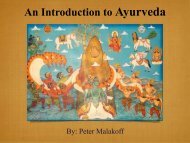How Thoreau's Walden Pond Mixed with the Ganges and Yoga Came to America with Swami Vivekananda
One early morning in 1846, during the coldest days of a New England winter, Henry David Thoreau looked out the window of his small cabin on Walden Pond and saw men cutting its ice into blocks. That ice was hauled by horse to a railroad that ran across the western edge of Walden Pond, packed into a boxcar, taken to Boston and loaded onto a clipper ship that sailed to Calcutta, India, arriving about four months later. Once there, that ice was purchased by grateful members of the East India Company. Thoreau had witnessed a small part of the global ice trade between New England and India that took place during the latter part of the nineteenth century. When Thoreau considered the ice trade, his vision sailed on metaphors far beyond the scope of business. The waters he imagined flowed both east and west and carried not just natural elements, but culture, religion and philosophy as well. He envisioned that after arriving in Calcutta, the New England ice of Walden Pond would eventually melt and run downhill where it would join with the sacred water of the Ganges. He wrote in Walden: "It appears that the sweltering inhabitants of Charleston and New Orleans, of Madras and Bombay and , drink at my well. In the morning I bathe my intellect in the stupendous and cosmogonal philosophy of the , since whose composition years of the gods have elapsed, and in comparison with which our modern world and its literature seem puny and trivial; and I doubt if that philosophy is not to be referred to a previous state of existence, so remote is its sublimity from our conceptions. I lay down the book [Bhagavad-Gita] and go to my well for water, and lo! there I meet the servant of the Bramin, priest of and and who still sits in his temple on the Ganges reading the , or dwells at the root of a tree with his crust and water jug. I meet his servant come to draw water for his master, and our buckets as it were grate together in the same well. The pure Walden water is mingled with the sacred water of the Ganges." This book tells the story of these waters . . .
One early morning in 1846, during the coldest days of a New England winter, Henry David Thoreau looked out the window of his small cabin on Walden Pond and saw men cutting its ice into blocks. That ice was hauled by horse to a railroad that ran across the western edge of Walden Pond, packed into a boxcar, taken to Boston and loaded onto a clipper ship that sailed to Calcutta, India, arriving about four months later. Once there, that ice was purchased by grateful members of the East India Company. Thoreau had witnessed a small part of the global ice trade between New England and India that took place during the latter part of the nineteenth century.
When Thoreau considered the ice trade, his vision sailed on metaphors far beyond the scope of business. The waters he imagined flowed both east and west and carried not just natural elements, but culture, religion and philosophy as well. He envisioned that after arriving in Calcutta, the New England ice of Walden Pond would eventually melt and run downhill where it would join with the sacred water of the Ganges. He wrote in Walden: "It appears that the sweltering inhabitants of Charleston and New Orleans, of Madras and Bombay and , drink at my well. In the morning I bathe my intellect in the stupendous and cosmogonal philosophy of the , since whose composition years of the gods have elapsed, and in comparison with which our modern world and its literature seem puny and trivial; and I doubt if that philosophy is not to be referred to a previous state of existence, so remote is its sublimity from our conceptions.
I lay down the book [Bhagavad-Gita] and go to my well for water, and lo! there I meet the servant of the Bramin, priest of and and who still sits in his temple on the Ganges reading the , or dwells at the root of a tree with his crust and water jug. I meet his servant come to draw water for his master, and our buckets as it were grate together in the same well. The pure Walden water is mingled with the sacred water of the Ganges."
This book tells the story of these waters . . .
Create successful ePaper yourself
Turn your PDF publications into a flip-book with our unique Google optimized e-Paper software.
Avatar<br />
Whenever a decrease in righteousness exists<br />
And <strong>the</strong>re is a rising up of unrighteousness<br />
Then I give forth myself<br />
for <strong>the</strong> protection of <strong>the</strong> good<br />
For <strong>the</strong> sake of establishing righteousness<br />
I come in<strong>to</strong> being from age <strong>to</strong> age<br />
—Bhagavad-Gita 4.7- 8<br />
An Avatar is one who has “descended or crossed down.” This is a sanskrit word<br />
that describes a special class of being in <strong>the</strong> Vedic/Hindu culture. It is <strong>the</strong> term<br />
for a direct Incarnation of God, a principle recognized by <strong>the</strong> Vedic/Hindu cultures.<br />
According <strong>to</strong> <strong>the</strong> Hindu tradition, <strong>the</strong>re have been many Avatars.<br />
The Christian concept of Jesus is <strong>the</strong> son of God, being <strong>the</strong> one <strong>and</strong> only incarnation<br />
of Divinity. In <strong>the</strong> Indian system <strong>the</strong>re have been many Avatars. Rama,<br />
Krishna, Buddha, <strong>and</strong> Jesus, as well as o<strong>the</strong>rs have been declared <strong>to</strong> be Avatars.<br />
Ramakrishna was declared <strong>to</strong> be an Avatar by many.<br />
Unlike a saint, who has attained <strong>to</strong> God-Realization in this life, an Avatar is one<br />
born already enlightened, for <strong>the</strong> sake of aiding <strong>and</strong> uplifting humanity.<br />
The nature of an Avatar may even be hidden during part of his life as part of<br />
<strong>the</strong> lila or play of his incarnation for <strong>the</strong> sake of demonstrating or teaching.<br />
The Ten Avatars of Vishnu<br />
“In Hinduism, an avatar, (from Sanskrit, avatāra "descent") is a deliberate descent<br />
of a deity <strong>to</strong> Earth, or a descent of <strong>the</strong> Supreme Being (e.g., Vishnu for<br />
Vaishnavites), <strong>and</strong> is mostly translated in<strong>to</strong> English as "incarnation,” but more<br />
accurately as "appearance" or "manifestation.”<br />
The term is most often associated <strong>with</strong> Vishnu, though it has also come <strong>to</strong> be<br />
associated <strong>with</strong> o<strong>the</strong>r deities. Varying lists of avatars of Vishnu appear in Hindu<br />
scriptures, including <strong>the</strong> ten Dashavatara of <strong>the</strong> Garuda Purana <strong>and</strong> <strong>the</strong> twentytwo<br />
avatars in <strong>the</strong> Bhagavata Purana, though <strong>the</strong> latter adds that <strong>the</strong> incarnations<br />
of Vishnu are innumerable. The avatars of Vishnu are a primary component<br />
of Vaishnavism. An early reference <strong>to</strong> avatar, <strong>and</strong> <strong>to</strong> avatar doctrine, is in<br />
<strong>the</strong> Bhagavad Gita.<br />
Shiva <strong>and</strong> Ganesha are also described as descending in <strong>the</strong> form of avatars.<br />
The various manifestations of Devi, <strong>the</strong> Divine Mo<strong>the</strong>r principal in Hinduism,<br />
are also described as avatars or incarnations by some scholars <strong>and</strong> followers of<br />
Shaktism. The avatars of Vishnu carry a greater <strong>the</strong>ological prominence than<br />
those of o<strong>the</strong>r deities, which some scholars perceive <strong>to</strong> be imitative of <strong>the</strong><br />
Vishnu avatar lists.<br />
In Sikhism, an avatar is a deliberate descent of a soul <strong>to</strong> earth in any form.”<br />
– Wikipedia <strong>the</strong> Free Encyclopedia


















